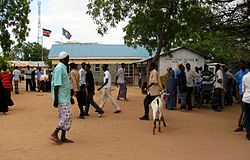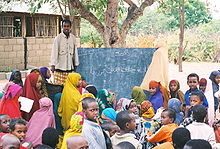Dadaab
| Dadaab | ||
|---|---|---|

|
||
| Basic data | ||
| county | Garissa County | |
| height | 124 m | |
| Coordinates | 0 ° 3 ′ N , 40 ° 19 ′ E | |
|
|
||
Dadaab is a village in Garissa County in Kenya , about 100 kilometers from the border with Somalia . The local population consists mainly of nomadic camel and goat herders. The largest proportion of the population, however, are the refugees who have come from Somalia since the early 1990s because of civil war and hunger and are housed in five camps.
The economy of Dadaab is mainly focused on services for the refugees.
Refugee camp
The UNHCR maintains in Dadaab, along with other aid agencies, who built in 1992 Hagadera refugee camp, Ifo and Dagahaley. The international aid organization CARE is the most important partner of the UNHCR in Dadaab and is responsible for running the refugee camp. After the outbreak of the Somali civil war and the associated famine in southern Somalia , up to 400,000 Somali refugees were in Kenya in the first half of the 1990s, most of them in Dadaab. In 2006 there were around 150,000. The remainder had returned to Somalia or - as in the case of 12,000 refugees from the Somali Bantu ethnic minority - were resettled to other countries.
In January 2007, Kenya largely closed its border with Somalia to refugees because it fears the influx of Islamist fighters from the Union of Islamic Courts . Due to heavy fighting in Somalia, the number of refugees has increased again since 2007. Since 2007 another refugee camp - Ifo 2 - has been set up in Dadaab 2007. However, it was only opened in November 2011, after the Kenyan government had opposed the opening for several years. In August 2011, the Kambioos refugee camp was established to relieve the Hagadera refugee camp. This expansion was made possible with a donation of 43 million euros from the IKEA Foundation . In January 2009, the Dadaab camps had a population of around 244,000. Most of them came from the border regions of Jubbada Hoose , Jubbada Dhexe and Gedo in southern Somalia, with newcomers mainly from the fiercely contested capital Mogadishu . At the end of 2011, almost 500,000 refugees were staying in the camps due to the hunger crisis in the Horn of Africa - triggered by two missing seasonal rainy seasons.
The high population density led to a poorer security, supply and health situation - there were two in 2007 and a cholera epidemic in 2011 , and the number of sexual assaults doubled between 2007 and 2008.
In November 2013, the foreign ministers of Somalia and Kenya signed an agreement in Mogadishu that enables the voluntary return of Somali refugees. Both sides agreed to set up a commission to coordinate the return. By February 2014, around 80,000 to 100,000 Somalis are said to have returned to their home country.
Development of the number of refugees
Total number of refugees and by camp at the end of the specified year. At the end of 2014, around 95% of the refugees were Somali and around 4% from Ethiopia .
| year | total | Dagahaley | Hagadera | Ifo | Ifo 2 | Kambioos |
|---|---|---|---|---|---|---|
| 1997 | 124,600 | |||||
| 1998 | 107,400 | |||||
| 1999 | 124,600 | |||||
| 2000 | 127.993 | 34,633 | 46.266 | 47.094 | ||
| 2001 | 134,000 | |||||
| 2002 | 136,450 | 33,920 | 51,810 | 50,720 | ||
| 2003 | 134,720 | 33,240 | 50,470 | 51.010 | ||
| 2004 | 138.620 | 34,500 | 51,930 | 52,190 | ||
| 2005 | 127,410 | 32,630 | 46,300 | 48,480 | ||
| 2006 | 152,868 | 39,526 | 59,185 | 54,157 | ||
| 2007 | 171,870 | 39,626 | 70.412 | 61,832 | ||
| 2008 | 235,453 | 65,581 | 90,403 | 79,469 | ||
| 2009 | 256.121 | 93,179 | 83,518 | 79,424 | ||
| 2010 | 292,586 | 93,470 | 101.506 | 97.610 | ||
| 2011 | 454,492 | 122.214 | 137,528 | 118,972 | 64,945 | 10,833 |
| 2012 | 446,289 | 121,127 | 139,483 | 98,294 | 69,259 | 18,126 |
| 2013 | 408,283 | 105,155 | 115,373 | 101,258 | 66,015 | 20,482 |
| 2014 | 356,014 | 89,147 | 107,679 | 85,444 | 52,651 | 21.093 |
literature
- Ben Rawlence : City of the Lost: Living in the largest refugee camp in the world . Translation from English by Bettina Münch and Kathrin Razum. Zurich: Nagel & Kimche, 2016
Web links
- Refugees in the Horn of Africa: Somali Displacement Crisis on the UNHCR website
- www.geoimage.ch/248957/250457.html ( Memento from February 11, 2015 in the Internet Archive ) - Satellite images of the three refugee camps around Dadaab by the German Earth observation satellite TerraSAR-X (data taken: August 2011)
- tagesschau.de : Dadaab refugee camp - Like a prison
Individual evidence
- ↑ A difficult neighborhood. faz.net, July 29, 2011, accessed February 11, 2015 .
- ↑ record! IKEA donates 43 million euros for refugees. (No longer available online.) UNHCR, August 31, 2011, archived from the original on February 11, 2015 ; accessed on February 11, 2015 .
- ↑ IRIN News: Kenya: Camp resources stretched by influx of Somali refugees
- ↑ IRIN News: Kenya-Somalia: Waiting in Dadaab for peace in Somalia
- ↑ 560,000 Somalis to return home following tripartite agreement. Daily Post, November 12, 2013, accessed February 11, 2015 .
- ^ Nairobi to open mission in Mogadishu. Standard Digital, February 19, 2014, accessed February 11, 2015 .
- ↑ a b c UNHCR Statistical Yearbook 2001. (pdf) UNHCR, accessed on December 25, 2015 (English).
- ↑ UNHCR Statistical Yearbook 1999. (pdf) UNHCR, accessed on February 10, 2015 (English).
- ↑ UNHCR Statistical Yearbook 2000. (pdf) UNHCR, accessed on February 10, 2015 (English).
- ↑ UNHCR Statistical Yearbook 2002 - Kenya. (pdf) UNHCR, accessed on February 10, 2015 .
- ↑ UNHCR Statistical Yearbook 2003 - Kenya. (pdf) UNHCR, accessed on February 10, 2015 .
- ↑ UNHCR Statistical Yearbook 2004 - Kenya. (pdf) UNHCR, accessed on February 10, 2015 .
- ↑ UNHCR Statistical Yearbook 2005 - Kenya. (pdf) UNHCR, accessed on February 10, 2015 .
- ↑ UNHCR Statistical Yearbook 2006. (pdf) UNHCR, accessed on February 10, 2015 (English).
- ↑ UNHCR Statistical Yearbook 2007. (pdf) UNHCR, accessed on February 10, 2015 (English).
- ↑ UNHCR Statistical Yearbook 2008. (pdf) UNHCR, accessed on February 10, 2015 (English).
- ↑ UNHCR Statistical Yearbook 2009. (pdf) UNHCR, accessed on February 10, 2015 (English).
- ↑ UNHCR Statistical Yearbook 2010. (pdf) UNHCR, accessed on February 10, 2015 (English).
- ↑ UNHCR Statistical Yearbook 2011. (pdf) UNHCR, accessed on February 10, 2015 (English).
- ↑ UNHCR Statistical Yearbook 2012. (pdf) UNHCR, accessed on February 10, 2015 (English).
- ↑ UNHCR Statistical Yearbook 2013. (pdf) UNHCR, accessed on February 10, 2015 (English).
- ↑ Alinjugur / Dadaab Camp Population Statistics. (pdf) (No longer available online.) UNHCR, December 31, 2014, archived from the original on March 5, 2016 ; accessed on February 10, 2016 .

